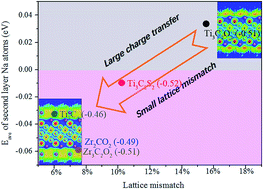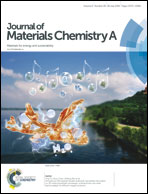Theoretical investigation of zirconium carbide MXenes as prospective high capacity anode materials for Na-ion batteries†
Abstract
Currently, MXenes have been identified as promising electrode material candidates because of their excellent energy storage and electrical conductivity. In the present study, Na adsorptions on 2D MXenes of Zr2C, Zr3C2, Zr2CO2, and Zr3C2O2 are explored by density functional theory (DFT) calculations. We have found that Zr2CO2/Zr3C2O2 MXenes show metallic behavior after Na adsorption and exhibit a low diffusion barrier (0.29/0.32 eV) and high storage capacity (up to Zr2CO2Na4/Zr3C2O2Na4 stoichiometry) for Na-ion batteries (NIBs). Zr2CO2/Zr3C2O2 MXenes also exhibit excellent properties such as good electrical conductivity, low diffusion barrier, decreased equilibrium open circuit voltage (OCV), and high theoretical capacity of Na storage, due to which they can be used as promising anode materials for NIBs. In addition, the physical origin of adsorption behavior of Na atoms on Zr2CO2/Zr3C2O2 as well as on Ti3C4, Ti3C2O2 and Ti3C2S2 MXenes is studied. Our results give insights into understanding the manner in which the theoretical capacity can be efficiently tuned by charge transfer and lattice mismatch factors, which will be useful for designing other 2D anode materials for NIBs.

- This article is part of the themed collection: 2018 Journal of Materials Chemistry A HOT Papers


 Please wait while we load your content...
Please wait while we load your content...